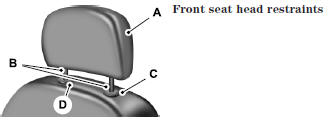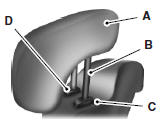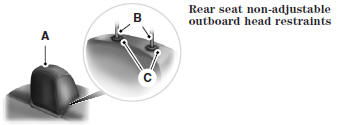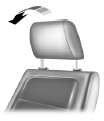WARNING:
To minimize the risk of neck injury in the event of a crash, the driver and passenger occupants should not sit in or operate the vehicle, until the head restraint is placed in its proper position. The driver should never adjust the head restraint while the vehicle is in motion.
WARNING:
The adjustable head restraint is a safety device.
Whenever possible it should be installed and properly adjusted when the seat is occupied.
WARNING:
Install the head restraint properly to minimize the risk of neck injury in the event of a crash.
Note
: Before adjusting any head restraint, adjust the seat back to an upright driving or riding position. Properly adjust the head restraint so that the top of the head restraint is even with the top of your head and positioned as close as possible to the back of your head. For occupants of extremely tall stature, adjust the head restraint to its full up position.
To adjust the head restraint, do the following:


Rear seat center head restraint
The head restraints consist of: A. An energy absorbing head restraint
B. Two steel stems
C. Guide sleeve adjust and release button
D. Guide sleeve unlock and remove button
• Raise: Pull up on the head restraint (A).
• Lower: Press and hold the guide sleeve adjust and release button (C) and push down on the head restraint (A).
• Remove: Pull up the head restraint until it reaches the highest adjustment position and then press and hold both the adjust and release button (C) and the unlock and remove button (D), then pull up on the head restraint.
• Reinstall: Align the steel stems into the guide sleeves and push the head restraint down until it locks.

The head restraints consist of: A. An energy absorbing head restraint
B. Two steel stems
C. Guide sleeve unlock and remove button
• Remove: Simultaneously press and hold both unlock and remove buttons (C), then pull up on the head restraint.
• Reinstall: Align the steel stems into the guide sleeves and push the head restraint down until it locks.
Tilting Head Restraints (If Equipped)
The front head restraints may tilt for extra comfort. To tilt the head restraint, do the following:

1. Adjust the seatback to an upright driving or riding position.
2. Tilt the head restraint forward by gently pulling the top of the head restraint.
Once it is in its forward-most position, tilt it forward once more to release it to the upright position.
Note: Do not attempt to force the head restraint backward after it is tilted. Instead, continue tilting it forward until the head restraint releases to the upright position.
 Sitting in the correct position
Sitting in the correct position
WARNING: Sitting improperly out of position or with the seat
back reclined too far can take off weight from the seat cushion
and affect the decision of the passenger sensing system, resulting in
se ...
 Front manual seats
Front manual seats
WARNING: Do not adjust the driver’s seat or seatback while the
vehicle is moving.
WARNING: Rock the seat backward and forward after releasing
the lever to make sure that it is fully engaged.
M ...
Other materials:
Removal and Installation
Antenna - Satellite Radio
Removal and Installation
NOTE: This procedure applies to both the stand-alone satellite radio
antenna and the combination satellite radio/Global Positioning System (GPS)
antenna.
Lower the headliner. For additional information, refer to Section
501-05.
...
Reporting safety defects (Canada only)
This pertains to vehicles delivered to authorized Canadian dealers.
In those cases, where you continue to feel that the efforts by Ford of
Canada and the authorized dealer to resolve a factory-related vehicle
service concern have been unsatisfactory, Ford of Canada participates in
an impartial ...
Fuel Charging and Controls - Turbocharger, 2.0L GTDI
SPECIFICATIONS
Torque Specifications
a Refer to the procedure in this section.
DESCRIPTION AND OPERATION
Turbocharger
Component Location
Overview
NOTICE: Whenever turbocharger air intake system components are
removed, always cover open ports to protect from debris. It is important that ...
